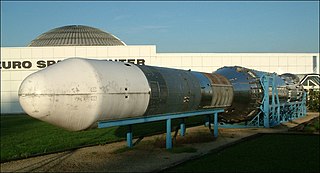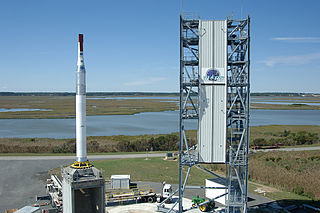
The de Havilland Propellers Blue Streak was a British Intermediate-range ballistic missile (IRBM), and later the first stage of the Europa satellite launch vehicle. Blue Streak was cancelled without entering full production.

The Europa rocket was an early expendable launch system of the European Launcher Development Organisation (ELDO), which was the precursor to the European Space Agency (ESA). It was developed with the aim to delivering space access technology, and more specifically to facilitate the deployment of European-wide telecommunication and meteorological satellites into orbit.

A scramjet is a variant of a ramjet airbreathing jet engine in which combustion takes place in supersonic airflow. As in ramjets, a scramjet relies on high vehicle speed to compress the incoming air forcefully before combustion, but whereas a ramjet decelerates the air to subsonic velocities before combustion using shock cones, a scramjet has no shock cone and slows the airflow using shockwaves produced by its ignition source in place of a shock cone. This allows the scramjet to operate efficiently at extremely high speeds.

A sounding rocket or rocketsonde, sometimes called a research rocket or a suborbital rocket, is an instrument-carrying rocket designed to take measurements and perform scientific experiments during its sub-orbital flight. The rockets are used to launch instruments from 48 to 145 km above the surface of the Earth, the altitude generally between weather balloons and satellites; the maximum altitude for balloons is about 40 km and the minimum for satellites is approximately 121 km. Certain sounding rockets have an apogee between 1,000 and 1,500 km, such as the Black Brant X and XII, which is the maximum apogee of their class. Sounding rockets often use military surplus rocket motors. NASA routinely flies the Terrier Mk 70 boosted Improved Orion, lifting 270–450-kg (600–1,000-pound) payloads into the exoatmospheric region between 97 and 201 km.

The NASA X-43 was an experimental unmanned hypersonic aircraft with multiple planned scale variations meant to test various aspects of hypersonic flight. It was part of the X-plane series and specifically of NASA's Hyper-X program developed in the late 1990s. It set several airspeed records for jet aircraft. The X-43 is the fastest jet-powered aircraft on record at approximately Mach 9.6.

The European Launcher Development Organisation (ELDO) is a former European space research organisation. It was first developed in order to establish a satellite launch vehicle for Europe. The three-stage rocket developed was named Europa, after the mythical Greek goddess. Overall, there were 10 launches that occurred under ELDO's funding. The organisation consisted of Belgium, Britain, France, Germany, Italy, and the Netherlands. Australia was an associate member of the organisation.
Scramjet programs refers to research and testing programs for the development of supersonic combustion ramjets, known as scramjets. This list provides a short overview of national and international collaborations, and civilian and military programs. The USA, Russia, India, and China (2014), have succeeded at developing scramjet technologies.

Lockheed L-301 was an experimental air-breathing hypersonic aircraft project. It was developed by the NASA and United States Air Force (USAF) organization National Hypersonic Flight Research Facility, with Skunk Works as the prime contractor. In January 1977, the program was "tentatively scheduled to operate two vehicles for eight years and to conduct 100 flights per vehicle." NASA discontinued work on L-301 and NHRF in September 1977 due to budget constraints and lack of need.

The Tupolev Tu-2000 was a planned hypersonic flight experimental aircraft designed by the Tupolev design bureau. It was intended to test technologies for a single-stage-to-orbit aerospaceplane and also the Tupolev Tu-360 intercontinental bomber.

Hypersonic flight is flight through the atmosphere below altitudes of about 90 km at speeds greater than Mach 5, a speed where dissociation of air begins to become significant and high heat loads exist. Speeds over Mach 25 have been achieved below the thermosphere as of 2020.

Non-rocket spacelaunch refers to theoretical concepts for launch into space where much of the speed and altitude needed to achieve orbit is provided by a propulsion technique that is not subject to the limits of the rocket equation. Although all space launches to date have been rockets, a number of alternatives to rockets have been proposed. In some systems, such as a combination launch system, skyhook, rocket sled launch, rockoon, or air launch, a portion of the total delta-v may be provided, either directly or indirectly, by using rocket propulsion.

ALV X-1 was the first and only flight of the ATK Launch Vehicle (ALV) sounding rocket developed by Alliant Techsystems. The launch occurred from LP-0B at the Mid-Atlantic Regional Spaceport (MARS) at NASA's Wallops Flight Facility. This mission carried the SOAREX-VI and Hy-BoLT experiments as payloads when it launched at 09:10 GMT on August 22, 2008. The vehicle was terminated 20 seconds into flight after veering too far off course.

Reusable Launch Vehicle–Technology Demonstration Programme is a series of technology demonstration missions that has been conceived by the Indian Space Research Organisation (ISRO) as a first step towards realising a Two Stage To Orbit (TSTO) re-usable launch vehicle, in which the second stage is a spaceplane.
HyShot is a research project of The University of Queensland, Australia Centre for Hypersonics, to demonstrate the possibility of supersonic combustion under flight conditions using two scramjet engines, one designed by The University of Queensland and one designed by QinetiQ.

The HSTDV is an unmanned scramjet demonstration aircraft for hypersonic flight. It is being developed as a carrier vehicle for hypersonic and long-range cruise missiles, and will have multiple civilian applications including the launching of small satellites at low cost. The HSTDV program is being run by the Defence Research and Development Organisation (DRDO).
The Boeing Small Launch Vehicle, or SLV, is an air-launched three-stage-to-orbit launch vehicle concept aimed to launch small payloads of 100 pounds (45 kg) into low Earth orbit. The program is proposed to drive down launch costs for small satellites as low as US$300,000 per launch ($7,000/kg) and could be fielded by 2020.
The DARPA XS-1 was an experimental spaceplane/booster with the planned capability to deliver small satellites into orbit for the U.S. Military. It was reported to be designed to be reusable as frequently as once a day, with a stated goal of doing so for 10 days straight. The XS-1 was intended to directly replace the first stage of a multistage rocket by taking off vertically and flying to hypersonic speed and high suborbital altitude, enabling one or more expendable upper stages to separate and deploy a payload into low Earth orbit. The XS-1 would then return to Earth, where it could ostensibly be serviced fast enough to repeat the process at least once every 24 hours.

The Mobile Rocket Base, abbreviated MORABA, is a department of the DLR Space Operations and Astronaut Training in Oberpfaffenhofen near Munich. Since the 1960s, the MORABA has performed scientific high altitude research missions with unmanned rockets and balloons, and has developed the required mechanical and electrical systems. Their operational areas include upper atmosphere research, microgravity research, astronomy, geophysics, materials science, as well as hypersonic research.
Scramspace was a hypersonic engine research project established by the University of Queensland, Australia's Centre for Hypersonics. It was a 1.8 meter long, free-flying, hypersonic scramjet. A scramjet is fundamentally an air-breathing engine that travels at hypersonic velocities. Built in Brisbane at an estimated cost of $14 million, it took approximately 3 years to complete. Scramspace was supposed to fire at a hypersonic velocity of Mach 8 or 8600 km/hour (5343 mph) but the flight-test turned out to be a failure and the rocket engine and the payload plummeted in the North Sea off the coast of Norway.
Hypersonix Launch Systems is an Australian space startup developing scramjet and scramjet-based access-to-space technology. In particular, the company is focused on reusable "green-fuelled" launch technology. The company specialises in hypersonic vehicle and scramjet engines to provide sustainable and affordable access to space.














